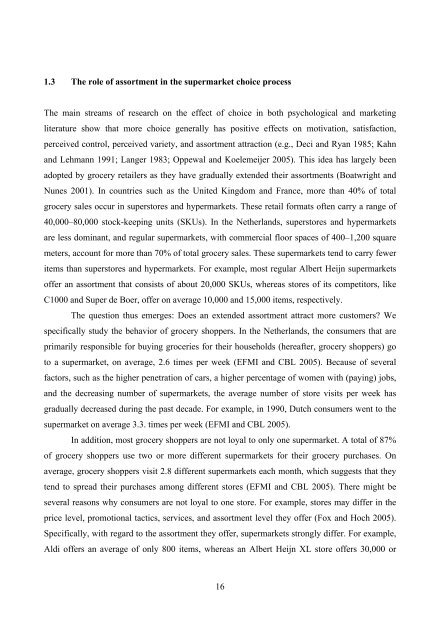Understanding Consumer Reactions to Assortment Unavailability
Understanding Consumer Reactions to Assortment Unavailability
Understanding Consumer Reactions to Assortment Unavailability
You also want an ePaper? Increase the reach of your titles
YUMPU automatically turns print PDFs into web optimized ePapers that Google loves.
1.3 The role of assortment in the supermarket choice process<br />
The main streams of research on the effect of choice in both psychological and marketing<br />
literature show that more choice generally has positive effects on motivation, satisfaction,<br />
perceived control, perceived variety, and assortment attraction (e.g., Deci and Ryan 1985; Kahn<br />
and Lehmann 1991; Langer 1983; Oppewal and Koelemeijer 2005). This idea has largely been<br />
adopted by grocery retailers as they have gradually extended their assortments (Boatwright and<br />
Nunes 2001). In countries such as the United Kingdom and France, more than 40% of <strong>to</strong>tal<br />
grocery sales occur in supers<strong>to</strong>res and hypermarkets. These retail formats often carry a range of<br />
40,000–80,000 s<strong>to</strong>ck-keeping units (SKUs). In the Netherlands, supers<strong>to</strong>res and hypermarkets<br />
are less dominant, and regular supermarkets, with commercial floor spaces of 400–1,200 square<br />
meters, account for more than 70% of <strong>to</strong>tal grocery sales. These supermarkets tend <strong>to</strong> carry fewer<br />
items than supers<strong>to</strong>res and hypermarkets. For example, most regular Albert Heijn supermarkets<br />
offer an assortment that consists of about 20,000 SKUs, whereas s<strong>to</strong>res of its competi<strong>to</strong>rs, like<br />
C1000 and Super de Boer, offer on average 10,000 and 15,000 items, respectively.<br />
The question thus emerges: Does an extended assortment attract more cus<strong>to</strong>mers? We<br />
specifically study the behavior of grocery shoppers. In the Netherlands, the consumers that are<br />
primarily responsible for buying groceries for their households (hereafter, grocery shoppers) go<br />
<strong>to</strong> a supermarket, on average, 2.6 times per week (EFMI and CBL 2005). Because of several<br />
fac<strong>to</strong>rs, such as the higher penetration of cars, a higher percentage of women with (paying) jobs,<br />
and the decreasing number of supermarkets, the average number of s<strong>to</strong>re visits per week has<br />
gradually decreased during the past decade. For example, in 1990, Dutch consumers went <strong>to</strong> the<br />
supermarket on average 3.3. times per week (EFMI and CBL 2005).<br />
In addition, most grocery shoppers are not loyal <strong>to</strong> only one supermarket. A <strong>to</strong>tal of 87%<br />
of grocery shoppers use two or more different supermarkets for their grocery purchases. On<br />
average, grocery shoppers visit 2.8 different supermarkets each month, which suggests that they<br />
tend <strong>to</strong> spread their purchases among different s<strong>to</strong>res (EFMI and CBL 2005). There might be<br />
several reasons why consumers are not loyal <strong>to</strong> one s<strong>to</strong>re. For example, s<strong>to</strong>res may differ in the<br />
price level, promotional tactics, services, and assortment level they offer (Fox and Hoch 2005).<br />
Specifically, with regard <strong>to</strong> the assortment they offer, supermarkets strongly differ. For example,<br />
Aldi offers an average of only 800 items, whereas an Albert Heijn XL s<strong>to</strong>re offers 30,000 or<br />
16

















